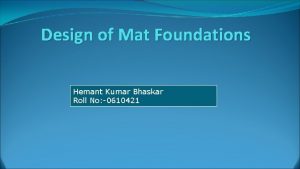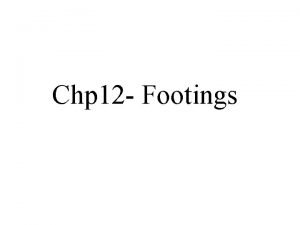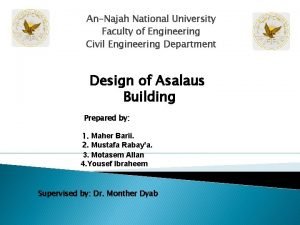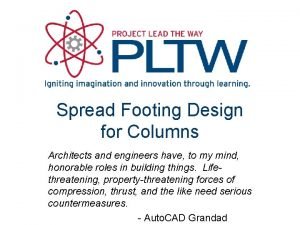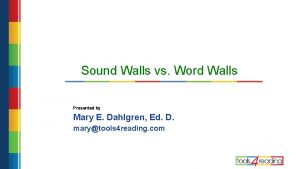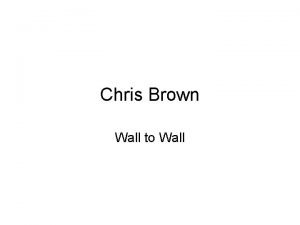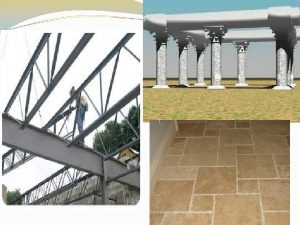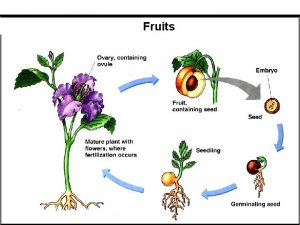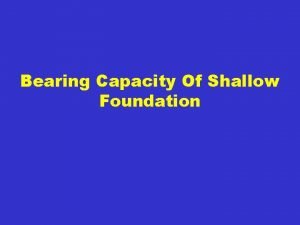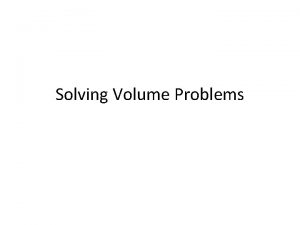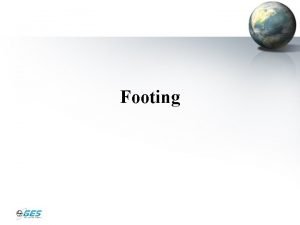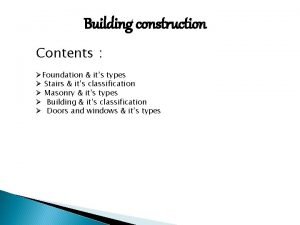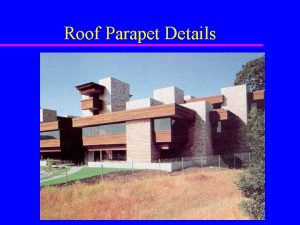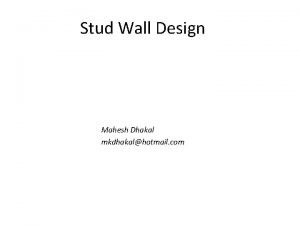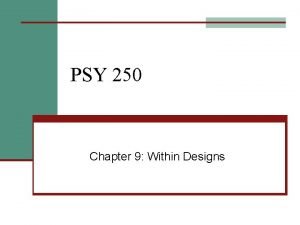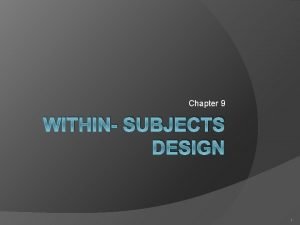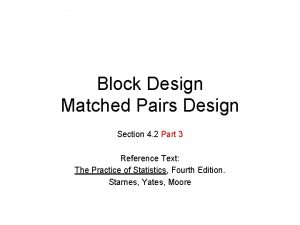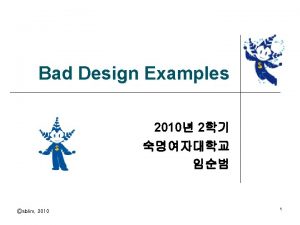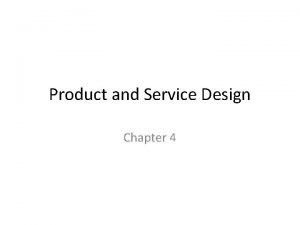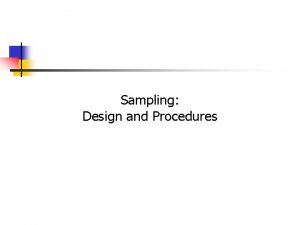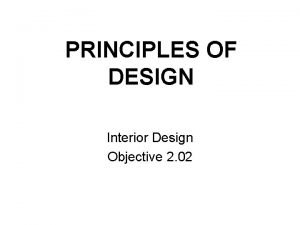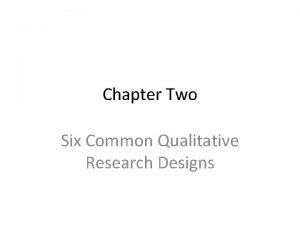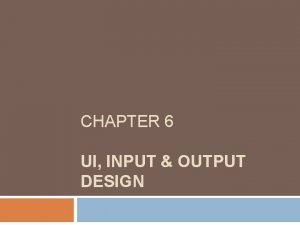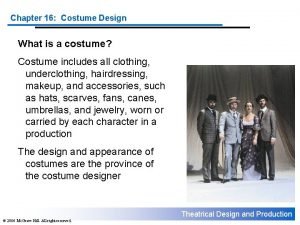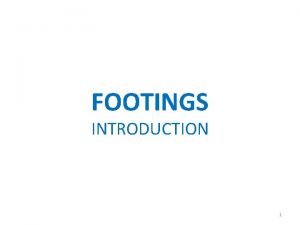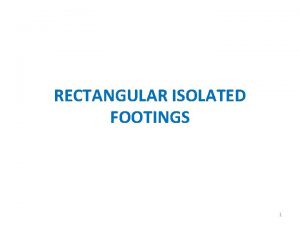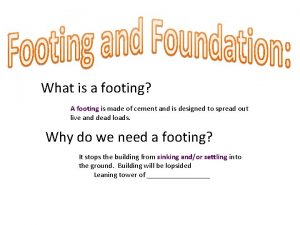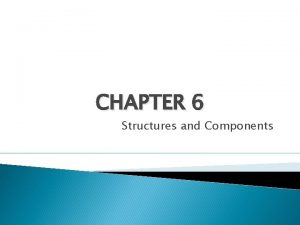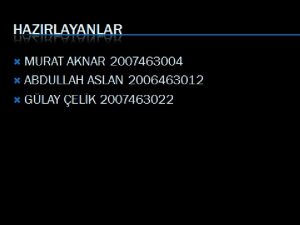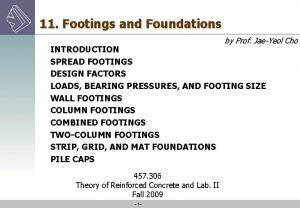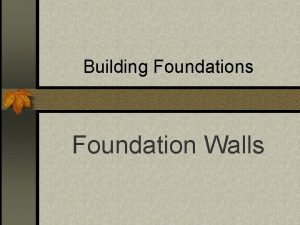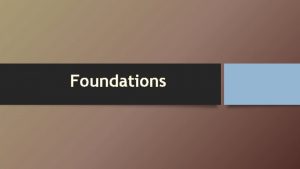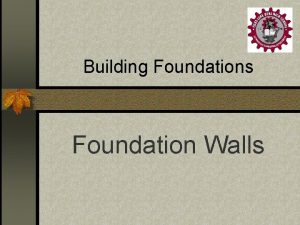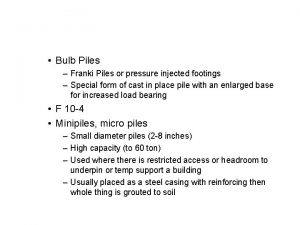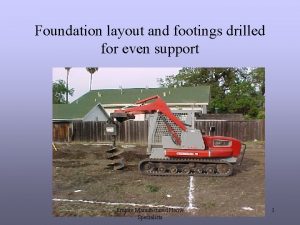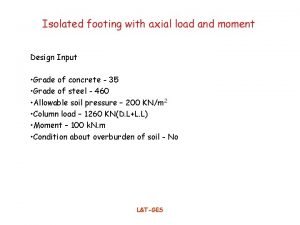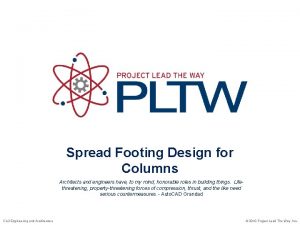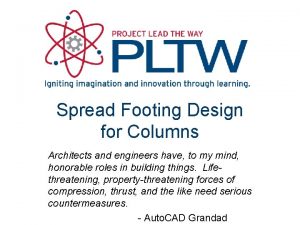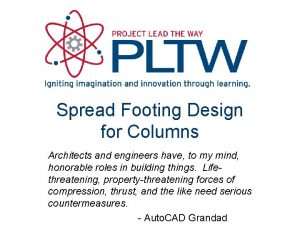Footing Design Types of Footing Wall footings are




























































- Slides: 60

Footing Design

Types of Footing Wall footings are used to support structural walls that carry loads for other floors or to support nonstructural walls.

Types of Footing Isolated or single footings are used to support single columns. This is one of the most economical types of footings and is used when columns are spaced at relatively long distances.

Types of Footing Combined footings usually support two columns, or three columns not in a row. Combined footings are used when two columns are so close that single footings cannot be used or when one column is located at or near a property line.

Types of Footing Cantilever or strap footings consist of two single footings connected with a beam or a strap and support two single columns. This type replaces a combined footing and is more economical.

Types of Footing Continuous footings support a row of three or more columns. They have limited width and continue under all columns.

Types of Footing Rafted or mat foundation consists of one footing usually placed under the entire building area. They are used, when soil bearing capacity is low, column loads are heavy single footings cannot be used, piles are not used and differential settlement must be reduced.

Types of Footing Pile caps are thick slabs used to tie a group of piles together to support and transmit column loads to the piles.

Distribution of Soil Pressure When the column load P is applied on the centroid of the footing, a uniform pressure is assumed to develop on the soil surface below the footing area. However the actual distribution of the soil is not uniform, but depends on may factors especially the composition of the soil and degree of flexibility of the

Distribution of Soil Pressure Soil pressure distribution in cohesionless soil. Soil pressure distribution in cohesive soil.

Eccentrically loaded footings



Eccentrically loaded footings Example Isolated Footing D. L = 900 k. N L. L = 450 k. N Ms = 150 k. N. m Mu=200 k. N. m qall =200 kpa M

Area required approximated 124. 7 Check stress 183. 7

Ultimate pressure under footing 245 166 245

Check Punching Shear

Check Beam Shear

3. 5 m Bending moment design Long direction 245 166 245

Bending moment design 2. 5 m Short direction 245 166 245

Central band ratio = Central band of short direction = 0. 83 As = 0. 83 (10. 1)=8. 6 cm 2


Footing Design Part II Combined footing

Example 1 Design a combined footing As shown

Dimension calculation The base dimension to get uniform distributed load 2000 k. N 800 k. N 1200 k. N A x 1=0. 2 m x 2=6. 2 m x 800(0. 2)+1200(6. 2)=2000(x) x = 3. 8 m 800 k. N 1200 k. N Try thickness =80 cm 2 x =7. 6 m

Area required

Check for punching Shear d = 730 mm 1. 13 m A 0. 765

B

Draw S. F. D & B. M. D Stress under footing = 190 *1. 8 = 342 k. N/m

Check for beam shear b = 1800 mm, d = 730 mm

Bending moment Long direction

Bending moment Short Under Column A direction

Under Column B Shrinkage Reinforcement in short direction


Footing Design Part III Combined footing, strip footing, & Mat foundatio

Example 2 Design a combined footing As shown

Dimension calculation The base dimension to get uniform distributed load 1950 k. N 1200 k. N 750 k. N A x 1=0. 2 m x 2=4. 2 m x 750(4. 2)+1200(0. 2)=1950 (x) x = 1. 75 m

Area required

Check for punching Shear h= 750 mm d = 732 mm A B 2=1 m B 1=4 m

B

Draw S. F. D & B. M. D

Empirical S. F. D & B. M. D m Convert trapezoidal load to rectangle Mmax Clear distance between column B in moment design = ave. width = 2. 5 m

Check for beam shear d = 665 mm b Y=1. 5 m x 4 m 1 m

Bending moment Long Top Bottom direction

Bending moment Short Under Column A direction

Under Column B Shrinkage Reinforcement in short direction

Reinforcement details

Example 3 (Strip footing) Design a combined footing As shown

Dimension calculation The base dimension to get uniform distributed load 3040 k. N 800 k. N 1280 k. N 960 k. N A Assume L 1=0. 6 x 1=5. 2 m x 2=10. 7 m x 800(0. 6)+1280(5. 1)+960(10. 6)= 3040 (x) x = 5. 65 m, 2(x)=11. 3 m L 2=11. 3 - (10. 6)=0. 7 L 2


Check for punching Shear h = 700 mm d=630 mm Example B You can check other columns

Draw S. F. D & B. M. D Stress under footing = 195 *1. 8 = 351 k. N/m

Check for beam shear b = 1800 mm, d = 630 mm

Bending moment Long Design Short direction as example 1 (lecture 11)

Reinforcement details

Mat Foundation


Check for punching Shear

General Example, Ref. 2 Modified load

General reinforcement details
 Antigentest åre
Antigentest åre T-accounts debits & credits simulation
T-accounts debits & credits simulation Mat
Mat Footing classification
Footing classification Design footing
Design footing Spread footing design example
Spread footing design example Sound wall vs word wall
Sound wall vs word wall Chris brown wall
Chris brown wall Stretcher bond t junction
Stretcher bond t junction Members used to carry wall loads over wall openings
Members used to carry wall loads over wall openings Pod fruit develops from
Pod fruit develops from Terzaghi's bearing capacity theory
Terzaghi's bearing capacity theory Supported scaffold
Supported scaffold Pencil footing in accounting
Pencil footing in accounting Terzaghi's bearing capacity theory
Terzaghi's bearing capacity theory Acknowledgement introduction
Acknowledgement introduction Surface area of prism
Surface area of prism Pencil footing
Pencil footing Serviceability failure
Serviceability failure Throating in building construction
Throating in building construction Roof parapet wall
Roof parapet wall Design load
Design load Retaining wall
Retaining wall Visual communication design study design
Visual communication design study design Design in output
Design in output Difference between structural design and decorative design
Difference between structural design and decorative design Naturalistic decorative design
Naturalistic decorative design Partial counterbalancing psychology
Partial counterbalancing psychology Split range
Split range Within subjects vs between subjects
Within subjects vs between subjects Between subjects vs within subjects
Between subjects vs within subjects Matched pairs design diagram
Matched pairs design diagram User interface design in system analysis and design
User interface design in system analysis and design Completely randomized design
Completely randomized design Elements and principles of interior design ppt
Elements and principles of interior design ppt Bad mapping design examples
Bad mapping design examples Repeated measures design vs independent measures design
Repeated measures design vs independent measures design Dialogue design in system analysis and design
Dialogue design in system analysis and design History of floral design crossword
History of floral design crossword Service design generally differs from product design
Service design generally differs from product design Conceptual design vs physical design
Conceptual design vs physical design Brief design
Brief design Study design types
Study design types Types of sample design
Types of sample design Types of roof design
Types of roof design Outline research design
Outline research design Study design types
Study design types Solomon four group design
Solomon four group design Radation in interior design
Radation in interior design Experimental research design types
Experimental research design types Types of qualitative designs
Types of qualitative designs List the types of output design
List the types of output design Practical considerations for costume design might include
Practical considerations for costume design might include Chapter 10 types of floral design
Chapter 10 types of floral design Types of between subjects design
Types of between subjects design Systematic random sampling
Systematic random sampling Types of evaluation design
Types of evaluation design What is rhythm in fashion
What is rhythm in fashion Fact finding and analysis
Fact finding and analysis Extraneous variable example
Extraneous variable example Types of evaluation design
Types of evaluation design


